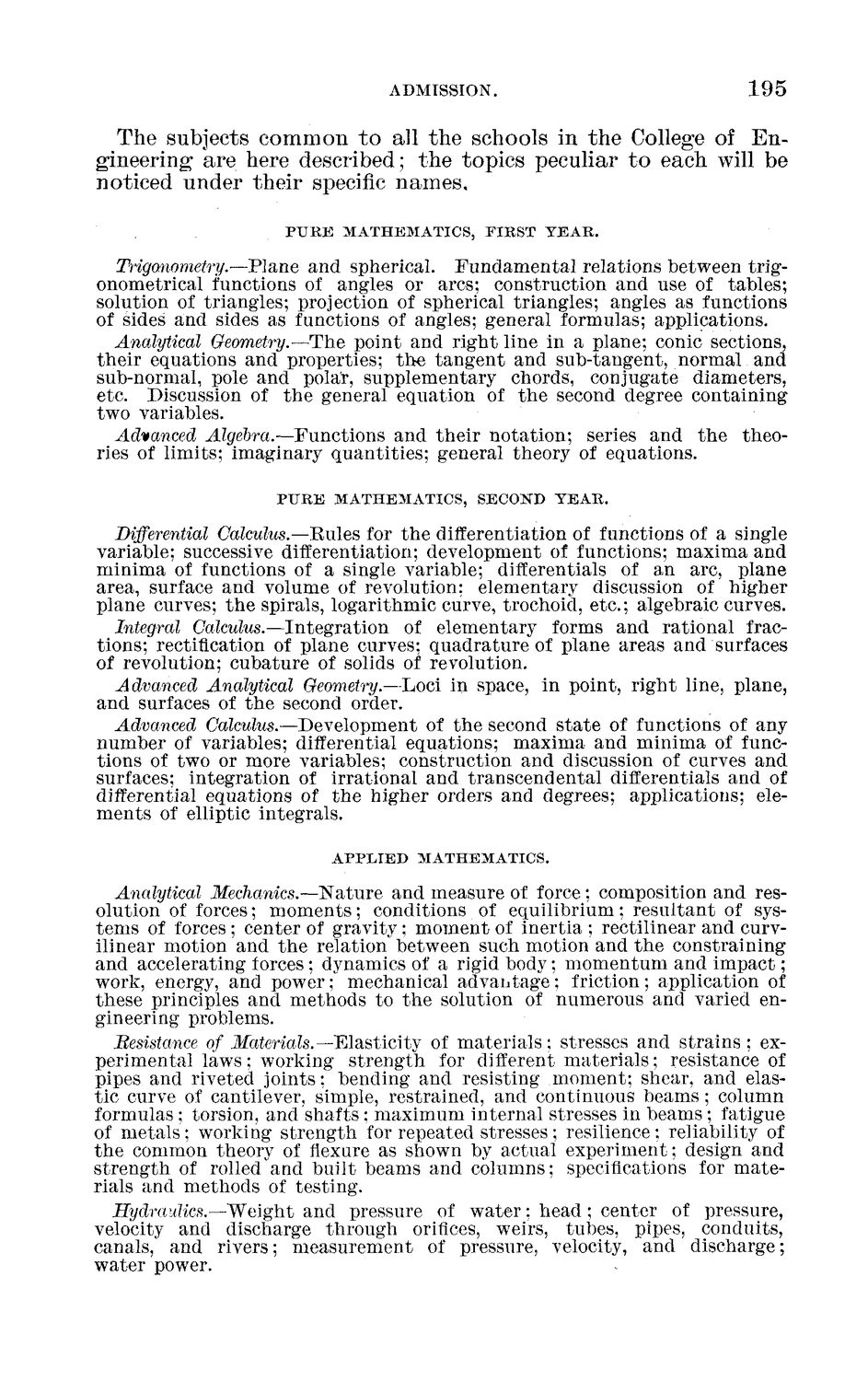| |
| |
Caption: Board of Trustees Minutes - 1890
This is a reduced-resolution page image for fast online browsing.

EXTRACTED TEXT FROM PAGE:
ADMISSION. 195 The subjects common t o all the schools in the College of Engineering are here described; t h e topics peculiar t o each will be noticed under their specific names, P U R E MATHEMATICS, F I R S T Y E A R . Trigonometry.—Plane and spherical. Fundamental relations between trigonometrical functions of angles or arcs; construction and use of tables; solution of triangles; projection of spherical triangles; angles as functions of sides and sides as functions of angles; general formulas; applications. Analytical Geometry.—The point and right line in a plane; conic sections, their equations and properties; the tangent and sub-tangent, normal and sub-normal, pole and polar, supplementary chords, conjugate diameters, etc. Discussion of the general equation of the second degree containing two variables. Advanced Algebra.—Functions and their notation; series and the theories of limits; imaginary quantities; general theory of equations. P U R E MATHEMATICS, SECOND Y E A R . Differential Calculus.—Kules for the differentiation of functions of a single variable; successive differentiation; development of functions; maxima and minima of functions of a single variable; differentials of an arc, plane area, surface and volume of revolution; elementary discussion of higher plane curves; the spirals, logarithmic curve, trochoid, etc.; algebraic curves. Integral Calculus.—Integration of elementary forms and rational fractions; rectification of plane curves; quadrature of plane areas and surfaces of revolution; cubature of solids of revolution. Advanced Analytical Geometry.—Loci in space, in point, right line, plane, and surfaces of the second order. Advanced Calculus.—Development of the second state of functions of any number of variables; differential equations; maxima and minima of functions of two or more variables; construction and discussion of curves and surfaces; integration of irrational and transcendental differentials and of differential equations of the higher orders and degrees; applications; elements of elliptic integrals. A P P L I E D MATHEMATICS. Analytical Mechanics.—Nature and measure of force; composition and resolution of forces; moments; conditions of equilibrium; resultant of systems of forces; center of gravity; moment of inertia ; rectilinear and curvilinear motion and the relation between such motion and the constraining and accelerating forces; dynamics of a rigid body; momentum and impact; work, energy, and power; mechanical advantage; friction; application of these principles and methods to the solution of numerous and varied engineering problems. Besistance of Materials.— Elasticity of materials; stresses and strains ; experimental laws; working strength for different materials; resistance of pipes and riveted joints; bending and resisting moment; shear, and elastic curve of cantilever, simple, restrained, and continuous beams ; column formulas ; torsion, and shafts: maximum internal stresses in beams; fatigue of metals; working strength for repeated stresses; resilience; reliability of the common theory of flexure as shown by actual experiment; design and strength of rolled and built beams and columns; specifications for materials and methods of testing. Hydraulics.— Weight and pressure of water; head ; center of pressure, velocity and discharge through orifices, weirs, tubes, pipes, conduits, canals, and rivers; measurement of pressure, velocity, and discharge; water power.
| |